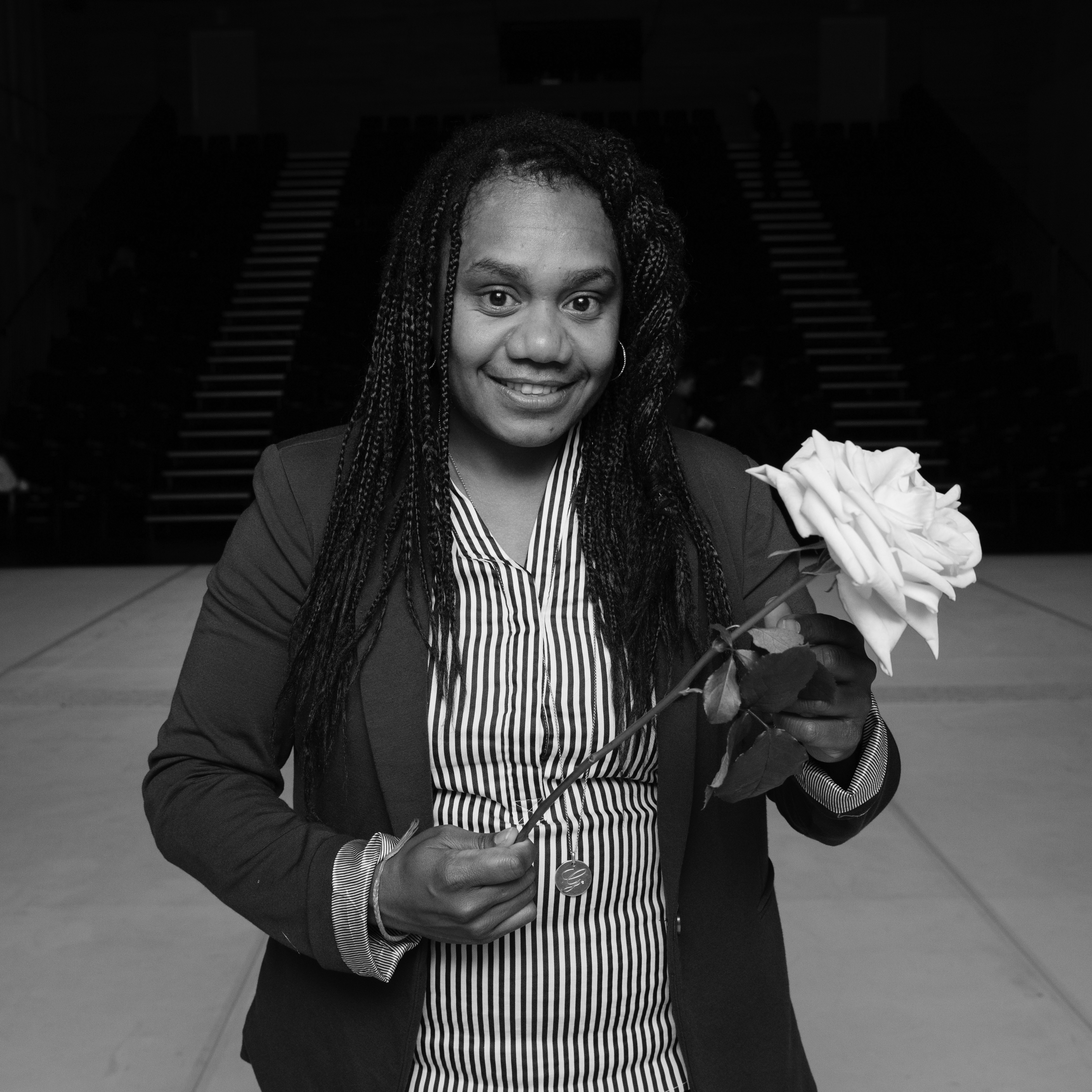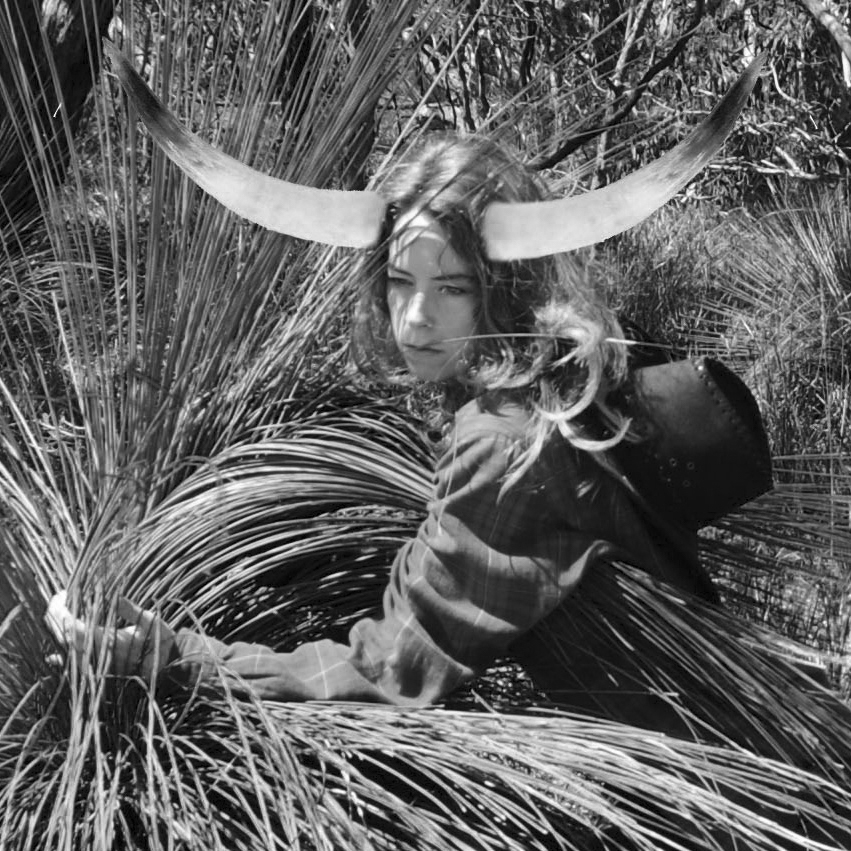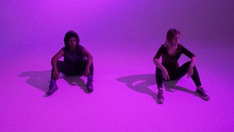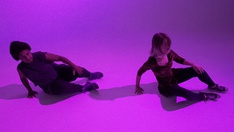Atlanta Eke
Melbourne
Ghenoa Gela
Sydney
2017
Displayed 2017 at Carriageworks

Ghenoa Gela
Born 1982, Rockhampton, Queensland. Lives and works Sydney
Kala Lagaw Ya/ Meriam Mir, Torres Strait region
Ghenoa Gela’s arts practice spans a variety of fields and experiences. Gela’s passion for the arts originates from her great passion for her Torres Strait Islander culture – telling stories, solidifying her traditional dance technique and sharing her culture. Her practice is heavily driven by a desire to share her culture and knowledge not only with her peers but also with wider Australian communities and, by extension, her audience members. This drive, together with her experience of being constantly confronted with western theatre constructs, motivates the work she eagerly creates.

Atlanta Eke
Born 1983, Melbourne. Lives and works Melbourne
Atlanta Eke is a dancer and choreographer concerned with dissolving pre-existing perceptions and expectations by changing fixed representations of the body through movement. She works with and beyond the limitations of the body, in collaboration with fellow dancers, artists and arts administrators in a variety of contexts. Her work with dance is currently project-specific. Within each project a question for the next arises, alongside an effort to deconstruct the modes of production and presentation of the previous work. Having recently had opportunities to present work in exhibition spaces, Eke is interested in how an exhibition space and timeframe can be utilised as a resource for developing dance.
Artist text
by Pip Wallis
The colonial narrative of Australia reaches the present through subjective records and imagined and retold fictions. Paul Carter describes the coloniser as ‘a novelist, making the lie of the land an index of his own fears and hopes’. (1) He recounts Robinson Crusoe’s encounter of a footprint on a beach, and charts the extraordinary ensuing mental path that conjures images of Satan and facilitates Crusoe’s Christian mission; all a mad chimera of heaven and hell within the imagination and projected onto the land.
We interpret the world not only through our senses but through science, symbolism, language, emotion and memory. ‘Reality is the coincidence of these different fictions’, writes the 20th-century philosopher Vilém Flusser. (2) Fiction is future-making; it is a literal ‘creation’. The cyborg, Donna Haraway writes, is ‘a condensed image of both imagination and material reality, the two joined centres structuring any possibility of historical transformation’. (3)
Imagining the possible is the very essence of future-making. And in that sense, fiction is a tool of the politically alienated, since emancipation is imagined before it is actualised, and science-fiction is deeply involved in the work of future-making and imagines our way out of oppression – whether that be oppression of gender, sexuality, race or of class. Because, in letting go of the essentialised body as it has been inscribed by systems of oppression, we have the freedom to imagine our (cyborg) bodies outside the colonial patriarchy.
In the making of The Unsettling (2017) Atlanta Eke and Ghenoa Gela have looked to the fictional violence in Horrorcore rap, a genre that carries the profound complexity of rage as a multidimensional response – historical, necessary and collective. Responding to the continued persecution of American black men, Horrorcore rappers articulate white America’s anxieties by lyrically realising unthinkable acts of fictitious, sociopathic violence. Here, we find fiction working as a reflexive tool. This reflexivity is at the heart of rap music, in which sampling and looping creates a ‘non-authoritative collaging or archiving of sound and styles that bespeaks a deconstructive hybridity where linearity and progress yield to a dizzying synchronicity’. (4)
This synchronicity underpins Eke and Gela’s work. They wade open-eyed into the present as an entanglement of cultural histories, collective and personal fictions, and, most importantly, into the conflicting and vibrating impulses, including rage, that emerge in each of us after generations of oppression in various forms. As in their previous independent works, Eke and Gela play self-reflexively with interpretational frameworks and source material unhinged from its own contentment; in doing so, they interrogate the context of their work in The National 2017: New Australian Art, the title of which infers a certain nationalism.
Working with experience, memory and historical accounts, The Unsettling suspects we can neither live through fiction nor live without it. As feminist, queer and black writing and art has shown, the lived experience of people in the world must fuel struggle in order to reflect the true experience of oppression. But we can also imagine beyond the actuality of our bodies and our current experience in order to bring about new futures.
Notes
(1) Paul Carter, ‘Friday’s other foot, Australian Humanities Review, April 1996, http://www.australianhumanitiesreview.org/archive/Issue-April-1996/Carter1.html.
(2) Vilém Flusser, ‘On fiction’, trans. Derek Hales and Erick Felinto, &&& Journal, 2016, http://tripleampersand.org/flusser-on-fiction/, originally published as ‘DA FICÇÃO’, Jornal O Diário de Ribeirão Preto, 26 August 1966.
(3) Donna Haraway, Simians, cyborgs and women: the reinvention of nature, Free Association Books, London, 1996, p.150.
(4) Houston A. Baker, Black studies, rap and the academy, University of Chicago Press, Chicago, 1993, p.89.

